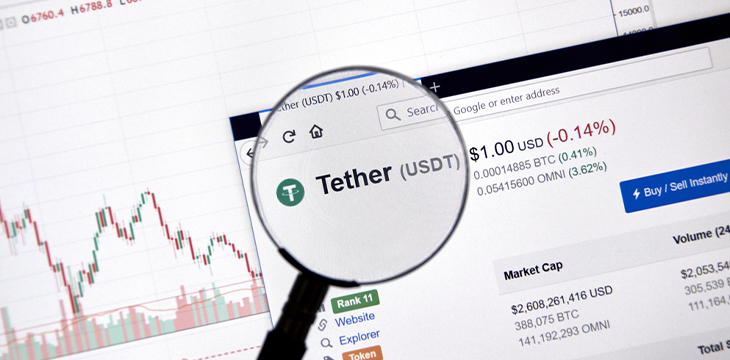|
Getting your Trinity Audio player ready...
|
Tether once again claims to have earned 10-figure profits from issuing its stablecoin but continues to dodge a third-party audit that might transform these claims into a verifiable reality.
On July 31, Tether issued its latest attestation report on the reserve assets allegedly backing up the over $113 billion in circulating USDT tokens as of June 30. That market cap was around $9 billion higher than on March 31, the date of Tether’s most recent attestation, and currently sits at over $114.4 billion.
BDO Italia, which prepared the report, once again stressed that it relied on information supplied by Tether that reflects only the company’s claimed state of affairs on June 30 and that BDO “did not perform procedures or provide any assurance at any other date or time in this report.”
This is an important caveat due to Tether’s history of rapidly moving funds in and out of accounts to provide the illusion of fiscal propriety, as in the case of trying to make the digital asset exchange Bitfinex—a sister company—appear solvent when the reality was the exact opposite.
With that dose of reality injected, let’s look at the numbers. Tether claims to have made $1.3 billion in ‘net operating profit’ in Q2, pushing its H2 total profit to $5.2 billion. Tether claims its reserves totaled $118.4 billion on June 30, $5.3 billion higher than the circulating USDT on that date.
The bulk of Tether’s reserves are allegedly represented by $81 billion in U.S. Treasury Bills, up from $74 billion in the Q1 report. Counting its other assets—including the roughly $11.3 billion in overnight reverse repurchase agreements and $6.4 billion in money market funds (both unchanged from Q1)—Tether claims its “direct and indirect” T-bill exposure hit a new high of $97.6 billion.
Tether allegedly custodies its T-bills with Wall Street player Cantor Fitzgerald (NASDAQ: ZCFITX), whose CEO Howard Lutnick addressed the issue of Tether’s reserves during his appearance at last weekend’s big BTC shindig in Nashville. Lutnick claimed that Tether had given Cantor “complete access to due diligence to see and prove that they had the money.”
Lutnick went on to say that Cantor’s original probe of Tether’s books showed that Tether “had every penny,” but some of it (at the time) was in Chinese commercial paper, something Tether’s representatives had previously denied.
Lutnick then claimed, “with absolute certainty that Tether USDT has every penny and it can produce liquidity on a moment’s notice.” That still doesn’t explain why Tether can’t produce an independent audit of its finances, and suspicion will continue to haunt this company until they do.
Loan arrangers
Given that Lutnick would be taking an immense legal risk by outright lying about Tether’s T-bills let’s turn our focus to the other, even less publicly verifiable items on Tether’s most recent balance sheet.
Let’s start with the ‘secured loans’ Tether promised to eliminate nearly two years ago. As of June 30, they totaled nearly $6.6 billion, around $1.9 billion higher than three months previous. Tether claims these loans are “over-collateralized by liquid assets subject to margin call and liquidation mechanisms,” but given that these loans now exceed Tether’s alleged surplus, it’s an area worth watching.
Tether’s haul of BTC tokens significantly decreased in value over the past three months, from nearly $5.4 billion in Q1 to $4.7 billion in Q2, reflecting the 13% plunge in the value of the token over that three-month span. (Another reason why nation-states might think twice about using BTC as a reserve asset.)
Tether previously vowed to allocate up to 15% of its ‘net realized operating profits’ to buy BTC but Tether appears to have abandoned its BTC buys since the end of Q1. Oddly, Tether CEO Paolo Ardoino promoted the Q2 report with a tweet that claimed Tether held ‘~80k’ BTC tokens, while the attestation math clearly indicates the total is unchanged from Q1 at 75,354 tokens.
Called out on X/Twitter over this discrepancy, Ardoino claimed that “Tether’s investment arm” also owns some BTC and bought more in Q2. But when asked whether the Tether mothership had officially abandoned its ‘buy BTC’ strategy, Ardoino failed to respond.
Tether’s supply of precious metals increased in value by around $165 million to $3.8 billion. As for actual cash on hand, there’s around $110 million, about 10% higher than the previous report.
Tether’s ‘other investments’ category showed a nearly $300 million decline to just over $3.5 billion. Tether has been bragging about diversifying its investments, including in Northern Data, a Germany-based BTC miner/AI data center that was recently sued by two former senior executives for “falsely misrepresenting the strength of its financial condition to investors, regulators and business partners.” This will end well, we’re sure.
Blame it on Liz
Forbes recently published an interview with Ardoino in which he once again deflected calls for an audit, citing his apparent belief that Tether can just ride out this storm until America’s shifting political winds lead to its embrace of all things ‘crypto’ and everyone just leaves Tether alone already.
“A big auditing firm might service 50,000 banks, and each of those banks would pay them maybe $1 million annually. Imagine that you have these 50,000 banks, and then you have one stablecoin company. What would your 50,000 customers say about the fact that you onboarded a stablecoin that is probably its strongest competitor? So, it is not very easy as a selling point for the big four companies (Deloitte, PwC, KPMG and EY). But I also think that given the [anti-crypto Senator Elizabeth] Warren problem, if a new government were more pro-crypto, that problem would probably solve itself.”
Ardoino isn’t likely to be thrilled by a new Project Pyxtrial report that dropped the same day as its attestation. The joint project of the Bank for International Settlements (BIS) and the Bank of England (BoE) explores “how technology solutions can enable the monitoring of asset-backed stablecoins’ balance sheets, providing insight into whether the backing assets exceed their liabilities at all times.”
Pyxtrial’s “prototype data analytics pipeline” aims to collect on-chain data from stablecoin-hosting platforms hourly and then compare those figures with issuers’ off-chain asset reserve figures. Pyxtrial acknowledges challenges in “proactively detecting issues in stablecoin backing,” including the lack of universal regulations that would compel stablecoin issuers to provide asset composition data.
Given Tether’s refusal to apply for permission to continue operating in Europe under the new Markets in Crypto Assets (MiCA) regulatory framework, we’re sure they’ll be only too eager to throw open their books for Pyxtrial to have a gander.
Anonymous Trader’s Alameda echoes
On July 24, Tether and its sister company Bitfinex lost their latest bid to dismiss a revised class action suit in the U.S. District Court for the Southern District of New York.
The complaint—the third version since the suit was launched in 2019—accuses the companies of engaging in “a scheme to manipulate the market price for certain cryptocommodities in connection with Defendants’ fraudulent issuance” of USDT.
The role played by Bitfinex and Tether (B/T) in artificially inflating the BTC token’s fiat value in 2017 through fraudulent wash trading has always been denied by the companies. However, for years, BTC’s price was consistently higher on Bitfinex than on other exchanges, with no rational explanation ever provided for this discrepancy.
The amended complaint filed on July 12 alleges that B/T “moved vast quantities of debased USDT [aka USDT “unbacked by any corresponding U.S. dollar collateral” and relying on “risky Bitfinex receivables worth far less than their nominal amount”] onto the market.” The accused did so “via an anonymous, non-party trader, and in doing so, artificially drove price increases in certain cryptocommodities.”
The Anonymous Trader, who isn’t a party to this litigation, was first mentioned in the plaintiffs’ filings in 2021. After receiving scads of unbacked USDT, Anonymous allegedly used the tokens in an automated cross-exchange arbitrage trading strategy that “artificially signaled demand to the market, leading to price inflation.” B/T offered Anonymous “a generous margin trading policy,” allowing him to “access and trade USDT on credit.”
The trading on credit allegations brings to mind Sam Bankman-Fried’s market maker, Alameda Research, which was allowed to trade on SBF’s FTX exchange despite running a negative balance. That privilege ultimately proved SBF’s undoing, as a series of bad bets by Alameda left FTX with a fiscal hole that SBF attempted to fill with billions in FTX customer cash. SBF is currently doing 25 years in federal prison after being convicted on charges of fraud and money laundering last November.
The amended complaint contains quotes in which B/T CFO Giancarlo Devasini admits that increasing a customer’s credit line would boost BTC’s fiat price. In a chat with a Bitfinex customer, Devasini says: “[T]hey don’t realize we wouldn’t need [USDT] if we wanted to pump [BTC] … I could give 1 trillion usd [credit] line on your account and then you can pump it to the moon without even touching [USDT].”
Devasini gave a deposition in October 2023 in which he acknowledged that issuing a substantial credit line “that is not backed by anything of an enormous amount of money” would cause customers to “use this fake money to buy an enormous amount of [BTC] and, therefore, the price will increase.”
Plausibly alleged manipulation
In allowing the amended complaint to be filed, U.S. District Judge Katherine Polk Failla noted that Devasini’s deposition, along with another deposition in September 2023, marked the first time the plaintiffs could obtain “critical details” about the alleged wrongdoing.
These details included “(i) the magnitude of Bitfinex’s receivables and how they were accounted for in Tether’s USDT reserves; (ii) the connection of those receivables to Bitfinex’s margin trading policy; and (iii) the Anonymous Trader’s relationship with the B/T Defendants.”
Rejecting most of B/T’s protestations, Failla ruled that the plaintiffs “plausibly allege that Defendants had and did exercise their ability to influence market prices through the unchecked issuance of debased USDT, leading to an artificial price for cryptocommodities.”
Failla also found that the complaint “plausibly alleges that the Anonymous Trader was simply the vehicle by which Defendants executed their scheme to manipulate cryptocurrency prices through the introduction of debased USDT en masse.”
The amended complaint’s 118 pages contain lots of other goodies, so if you haven’t already, carve out an hour this weekend and tuck in.
Watch: Teranode is the future of the Bitcoin network

 01-18-2026
01-18-2026 




